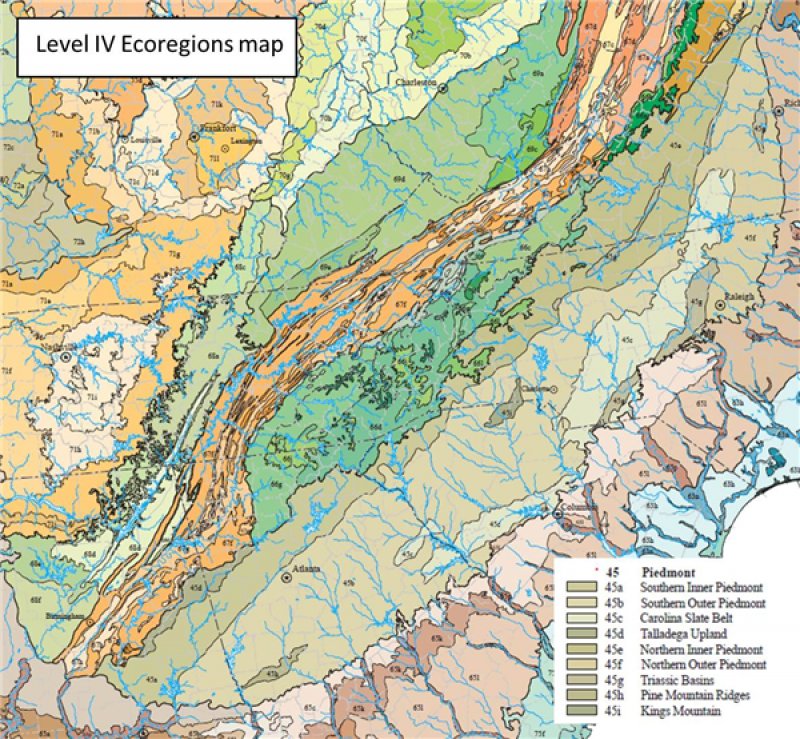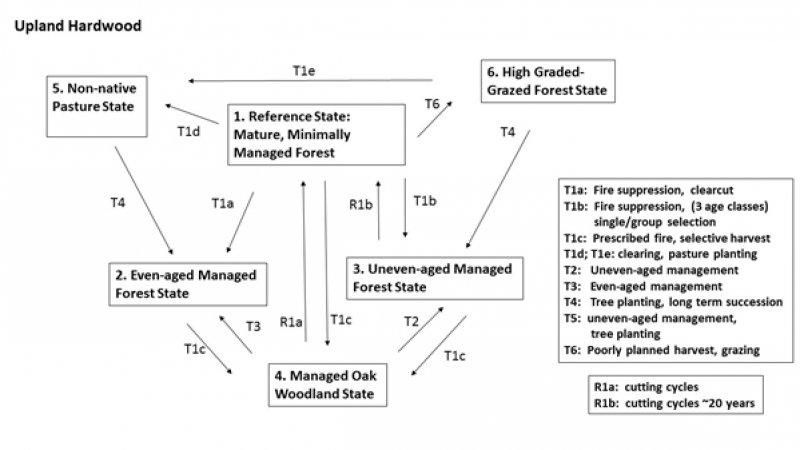
Natural Resources
Conservation Service
Ecological site PX136X00X430
Triassic Basin Upland Forest, Dry
Accessed: 01/05/2025
General information
Provisional. A provisional ecological site description has undergone quality control and quality assurance review. It contains a working state and transition model and enough information to identify the ecological site.
MLRA notes
Major Land Resource Area (MLRA): 136X–Southern Piedmont
This area is in North Carolina (29 percent), Georgia (27 percent), Virginia (21 percent), South Carolina (16 percent), and Alabama (7 percent). It makes up about 64,395 square miles (166,865 square kilometers). (Ag Bulletin 296)
The northeast-southwest trending Piedmont ecoregion comprises a transitional area between the mostly mountainous ecoregions of the Appalachians to the northwest and the relatively flat coastal plain to the southeast. It is a complex mosaic of Precambrian and Paleozoic metamorphic and igneous rocks with moderately dissected irregular plains and some hills. (EPA Ecoregions descriptions)
ADD APPROPRIATE ECOREGION DESCRIPTION(S)
Classification relationships
A PROVISIONAL ECOLOGICAL SITE is a conceptual grouping of soil map unit components within a Major Land Resource Area (MLRA) based on the similarities in response to management. Although there may be wide variability in the productivity of the soils grouped into a Provisional Site, the soil vegetation interactions as expressed in the State and Transition Model are similar and the management actions required to achieve objectives, whether maintaining the existing ecological state or managing for an alternative state, are similar. Provisional Sites are likely to be refined into more precise group during the process of meeting the APPROVED ECOLOGICAL SITE DESCRIPTION criteria.
This PROVISIONAL ECOLOGICAL SITE has been developed to meet the standards established in the National Ecological Site Handbook. The information associated with this ecological site does not meet the Approved Ecological Site Description Standard, but it has been through a Quality Control and Quality Assurance processes to assure consistency and completeness. Further investigations, reviews and correlations are necessary before it becomes an Approved Ecological Site Description.
Ecological site concept
This ecological site includes forests dominated by a mixture of Pinus echinata and mesophytic and dry-mesophytic oaks (e.g., Quercus alba, Quercus rubra, Quercus velutina) occurring in the Southern Piedmont. These forests occur on low to middle slope positions, on protected to intermediately exposed sites. The mixed evergreen - deciduous canopy is dominated by Pinus echinata and Quercus alba, sometimes with high coverage of other Quercus spp. (Quercus velutina, Quercus coccinea, Quercus falcata, Quercus rubra). Xerophytic Quercus spp. such as Quercus prinus, Quercus stellata, as well as other species of pines, may be present but are typically not abundant. A well-developed subcanopy is typical, with species such as Acer rubrum, Nyssa sylvatica, Carya glabra, Cornus florida, and Oxydendrum arboreum. The shrub stratum is sparse to patchy with low shrubs (Vaccinium pallidum, Vaccinium stamineum, Vaccinium arboreum, Chimaphila maculata) and vines (Vitis rotundifolia). The herb stratum is patchy to absent. Hexastylis arifolia is a typical herb. Stands without fire management may experience invasion by Acer rubrum. Piptochaetium avenaceum may be an important grass in more open stands.
Table 1. Dominant plant species
| Tree |
(1) Pinus echinata |
|---|---|
| Shrub |
(1) Vaccinium pallidum |
| Herbaceous |
Not specified |
Legacy ID
F136XY430NC
Click on box and path labels to scroll to the respective text.

